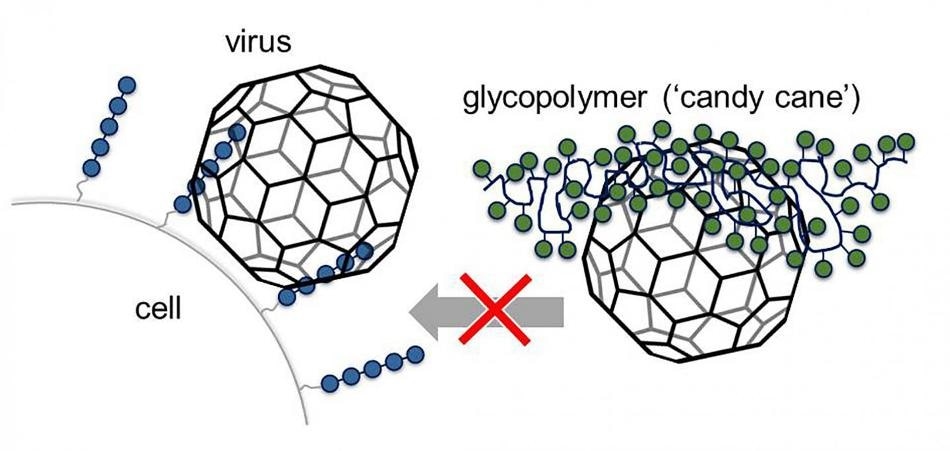Viruses are responsible for causing many different diseases, with the present coronavirus pandemic being one such example. Hence, these infectious agents are part of the human experience all through their lives.

The artificially manufactured glycomimetics (green) attach to the viruses' binding sites, which viruses normally use to attach to sugars (blue) on the cell surface. Image Credit: L. Hartmann, M. Schelhaas.
Although vaccines offer effective protection from viral infections, they are only available for specific viruses. This is the reason why antiviral drugs should be identified to treat or prevent a viral infection.
One of the successful approaches involves the use of unique molecules to inhibit viral proteins that otherwise would help the virus to adhere to the surface of the host cell.
After a virus attaches to the surface of the cell, it can infect this cell with its genome and reprogram it for its own uses. But a majority of the antiviral drugs become less effective over a period of time because viruses can mutate rapidly and hence usually adapt to the antiviral or medication utilized.
The team of researchers—headed by HHU Professor Dr. Laura Hartmann from the Institute of Macromolecular Chemistry and Münster-based Professor Dr. Mario Schelhaas from the Institute of Cellular Virology working along with Professor Dr. Nicole Snyder from Davidson College in North Carolina, United States—has employed the technique of inhibiting the initial contact between the cell and the virus to prevent infection at the onset.
Unique proteins are often used by viruses to adhere to sugar molecules on the surface of cells. In addition to others, these sugars contain long-chain glycosaminoglycans (GAGs) that carry a powerful negative charge. Heparan sulfate is one such GAG.
The scientists are already aware that GAGs can minimize virus infections if they are introduced externally. But natural polysaccharides can have adverse effects that are caused by impurities or their own biological function in the organism.
Currently, the researchers are manipulating the advantages of GAGs while disabling their disadvantages. The concept is to utilize the molecules synthesized artificially and in a regulated manner, that is, the so-called glycomimetics that were created at HHU.
These molecules contained a long synthetic scaffold that had side chains with tiny sugar molecules fixed to them.
In Düsseldorf, shorter chains containing up to 10 lateral sugars, also called oligomers, as well as longer chains containing up to 80 sugars, referred to as glycopolymers, have been developed. The chemists combined sulfate groups to the sugars to activate a highly charged state of natural GAGs.
At the University Hospital Münster, Professor Schelhaas subsequently used cell cultures to examine the antiviral characteristics of these “candy canes” of differing lengths.
At first, Professor Schelhaas’ team used those cell cultures against Human Papillomaviruses, which can cause diseases like cervical cancer. The team found that both long-chain and short-chain synthetic molecules have an antiviral impact but had a different mode of action.
As predicted, the virus was prevented from attaching to the cells by the more effective, long-chain molecules and, on the other hand, the short-chain molecules showed antiviral activity after binding to the cell, giving the assumption that these molecules remain active in the organism for a longer period of time.
It is very likely that the long-chain molecules occupy the binding sites of the virus to the cell and thus block those sites. The short-chain molecules apparently do not block these sites. The next step is to test our hypothesis that these molecules prevent the redistribution of proteins in the virus particle so that the viruses cannot infect the cell.”
Mario Schelhaas, Professor, Institute of Cellular Virology
In an animal model, effectiveness was confirmed for the Papillomaviruses. The compounds were found to be active against four other viruses, including Herpes viruses, which cause encephalitis, cold sores, and Influenza viruses that lead to flu.
Hartmann added, “Glycomimetics are thus promising compound molecules that could potentially be used in the fight against a large number of different viruses. The next thing to do is to examine the precise way in which the glycomimetics work and how they can be further optimized.”
Further research will focus on how fast viruses may adapt to this new class of compounds. With the short-chain molecules in particular, we are hopeful that viruses will find it harder to launch a counterattack.”
Mario Schelhaas, Professor, Institute of Cellular Virology
Source:
Journal reference:
Soria-Martinez, L., et al. (2020) Prophylactic Antiviral Activity of Sulfated Glycomimetic Oligomers and Polymers. Journal of American Chemical Society. doi.org/10.1021/jacs.9b13484.